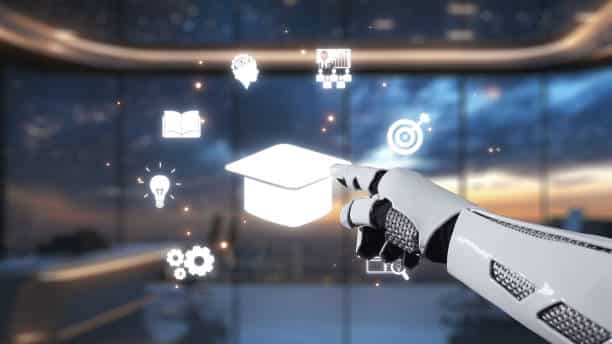In order to grow and expand enrollment, educational institutions must adapt their processes and automate in accordance with the ever-changing student population. What’s the secret to a seamless integration of chatbots that creates positive experiences for students in higher education?
Let’s take a look at the facts before you start doubting autoresponders for your marketing campaigns or student inquiries. Top chatbots are becoming more innovative, conversational, and powered by AI models. Attracting potential customers without resorting to robotic voices.
Are you considering using chatbots to save time and resources in higher education? In this article, we’ll look at current examples as well as popular use cases within higher education – along with tips for implementation with your students.
What Are Chatbots in Higher Education?
Chatbots (automated virtual personal assistants) are tools and technologies that use artificial intelligence (AI) and natural language processing (NLP) to provide real-time answers to individuals, students, or customers in real time.
AI-powered chatbots in higher education institutions resemble those used in other industries or contexts, replacing predictable communication patterns between students, faculty, and recruiters with AI technology.
Natural language processing (NLP) helps create a higher education chatbot. This system provides common language responses through a text interface. Conversations can happen online, via text, in an app, or on a chat-based engagement platform.
Common AI Chatbots for Higher Education
There are many unique ways a college or university can use chatbot services and platforms:
1. Website Lead Generation
Chatbots are an efficient way for websites and universities to engage new visitors and collect important data such as contact details or other pertinent details from these visitors quickly and accurately. Chatbots also enable instantaneous feedback to prospective students examining degree options.
2. Enhancing student experience through support services
Chatbots provide students with 24/7 assistance by answering academic issues or other common concerns. Such support can be found at admissions offices, financial aid providers, IT ticketing systems and more.
Chatbots provide quick, straightforward solutions that enable students to continue learning without experiencing additional anxiety. This is often a better alternative than waiting for a professor’s response, sitting through a long phone call, or navigating campus to find help.
3. Data Collection from Inquiries
Chatbots systematically gather data from students in order to enhance future interactions, which allows schools to refine their inquiry process, identify common problems and address roadblocks during enrollment processes.
4. Admissions Assistance and Onboarding
AI chatbots make the admissions process more efficient by providing real-time resources and guidance, answering questions about deadlines, tracking application statuses and supporting students with document submission or orientation registration – helping to reduce admissions staff workload and ensure an easier onboarding experience for newcomers.
5. Academic Advice and Course Recommendations
AI chatbots increasingly serve as academic advisors. They provide tailored course recommendations based upon student goals and progress. They also offer advice on prerequisites and credit requirements and keep students on track to graduation. Chatbots are also able to identify students who may be at risk of failing and can direct them to advisors in order to receive additional support. This will ultimately lead both academically as well as with student confidence.
AI Chatbots for Higher Education – Benefits
Investing in AI tools can improve the student experience. Chatbots can be used to improve admissions and enrollment.
- Student Achievement Has Increased: Chatbots provide invaluable services at any hour of day or night, providing information and assistance unavailable through direct human interactions.
- Cost Savings Opportunities: Automation eliminates bottlenecks, delays and communication gaps while connecting students with answers they require – saving both resources and connecting students with answers they require.
- Error Reduction Strategies: Chatbots leverage stored data, eliminating errors due to human intervention or administrative oversight and providing more precise responses than human counterparts.
Current Chatbot Trends in Colleges and Universities
EdTech Magazine reported that AI discussion in higher education has grown since platforms such as ChatGPT were introduced. Conversational AI was particularly useful during the COVID-19 pandemic, when schools were in a hurry to communicate without having to meet.
According to The Chronicle of Higher Education, chatbots are quickly becoming the go-to provider of services for students who grew up with technology. Chatbots offer targeted support that is tailored to meet student expectations and preferences.
How Can Chatbots Be Implemented in Higher Education Institutions
Acknowledging what and why you are launching is vital to its success, while optimizing the process to effectively introduce chatbots to students is necessary for effective integration.
Here are a few strategies for success:
1. Engaging Your Chat Tool Personally and Emotionally
Artificial intelligence chatbots may seem insensitive; however, with technological progress coming at us faster and faster, AI chatbots have become better at building relationships – something essential to retention rates, graduation rates and overall student satisfaction.
Personalization is of utmost importance; although you’re automating processes to produce faster and better results, students should feel supported and empowered after engaging in these interactions.
2. Integrate Comprehensively to Assist Students
An effective chatbot must be adaptive and intelligent enough to serve diverse student populations, with secure access to student platforms such as their portal. Furthermore, it should answer queries related to registration, financial aid and other administrative matters.
Chatbots must also offer:
- Communications across multiple devices and platforms must remain uninterrupted and effective.
- Safe data handling to safeguard student privacy.
- Multilingual capabilities to support diverse student populations and eradicate biases.
3. Put Together an Educational Technology Strategy, Plan, and Boundaries
Establishing an AI chatbot implementation strategy can reduce internal friction and save money while improving student experiences by creating one clear understanding among all parties of goals, expectations, and benchmarks.
Campus leaders must collaborate with teams and departments in order to accomplish common goals. For instance, marketing may use a website chatbot to gather inquiries that are then passed onto recruiting.
Conclusion
Chatbots are revolutionizing higher education, streamlining processes, improving student experiences and saving precious time and resources. Offering 24/7 support services such as personalizing interactions and automating routine tasks, chatbots help institutions improve enrollment rates, student success rates and provide more connected services to their communities. As technology progresses, AI chatbots will not only meet today’s digital native students’ needs but will also lead to greater innovation and success down the road.











Leave a Comment